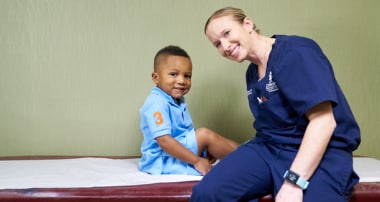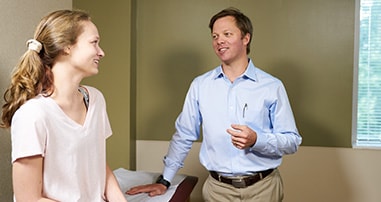Hip Apophysitis
Apophyses are the cartilage sites found throughout the body where muscles and tendons attach. There are several apophyses that are located in the hip and pelvic region. When your child is diagnosed with apophysitis—an overuse injury—he has an irritation from repetitive pulling, which can cause the cartilage to partially pull away from the bone. It typically occurs in athletes. Sometimes the cartilage can pull away from the bone enough to cause an apophyseal avulsion fracture, making it difficult to walk.
Repeated movement and stress to the muscles attached to the bone can inflame and irritate the muscles. This can cause inflammation at the point where the tendon (soft tissue) attaches to the bone. It can cause pain, swelling and tenderness in the hip area, resulting in an injury known as hip apophysitis.
Hip apophysitis is common in children and teens ages 12 to 18 who have:
- Growth spurts, in which bone growth can put added stress on the muscle
- Tight hips and thigh muscles
- Been training or competing in sports for long periods of time
- Knock knees and pronation (inward roll of the foot)
Young athletes are prone to hip apophysitis, especially if they are:
- Dancers
- Hockey players
- Runners
- Soccer players
- Sprinters
Apophysitis of the ischial tuberosity
The ischial tuberosity is the portion of the pelvis bone we sit on. The hamstring muscles start in this area and help the hip extend backward. Avulsion fractures, in which the tendon or ligament attached to the bone are pulled away (like apophyseal avulsion fractures), are more common at this location than overuse pain.
Apophysitis of the ASIS
The anterior superior iliac spine (ASIS) is located on the front part of the pelvis bone. It is the large area just underneath the iliac crest (the top of the two hipbones you typically rest your hands on) and roughly in line with the kneecap. The sartorius muscle starts at the ASIS and bends the hip up (flex). When this muscle is repetitively stretched out, an ASIS apophysitis may develop. It is more common to experience an avulsion fracture in this location.
Apophysitis of the iliac
The iliac apophysis is located on the iliac crest on the upper pelvis. Muscles of the back, abdomen and sides of the torso connect here. Athletes who participate in activities that involve repetitive twisting and bending of the torso, such as a long-distance runner, are at risk for iliac apophysis. Symptoms of iliac apophysitis include pain and tenderness over the iliac crest.
Apophysitis of the lesser trochanter
The lesser trochanter is another area at risk for injury and is located on the top, inside portion of the femur (thighbone). A strong muscle called the iliopsoas inserts on this bony prominence, which is the most powerful flexor of the hip. Injury may occur during activities like kicking, sprinting and jumping when the muscle is repeatedly stretched beyond its limits. Symptoms may include pain in the groin and difficulty walking or bending at the hip when seated.
Symptoms of hip apophysitis may include:
- Dull pain in the groin or front side of the hip
- Pain or discomfort that gets worse when activity is continued
- Tenderness and swelling at the site of the injury
Apophysitis is often mistaken for muscle strain.
At Children’s Healthcare of Atlanta, we help make diagnosing hip apophysitis as simple as possible.
Most cases are identified through:
- Complete medical history and physical examination
- X-ray
Our team of pediatric orthopedists will recommend a recovery plan tailored to your child’s needs.
Treatment may include:
- Resting from the activity that is causing the pain and inflammation.
- Icing the injured area for 15 to 20 minutes during a three-hour span every day.
- Taking medication to help reduce inflammation.
- Participating in physical therapy to help build strength and flexibility.
Be careful about letting your child return to sports after the pain has subsided. If he can’t walk normally without a limp, he likely isn’t ready to return to sports. When the pain is gone, gentle stretching and strengthening of the area can begin. Returning to sports and other activity should be gradual. The symptoms of hip apophysitis may come and go as your child gets older. But it should stop when he stops growing.
Support on Facebook
Contact Us 404-255-1933

